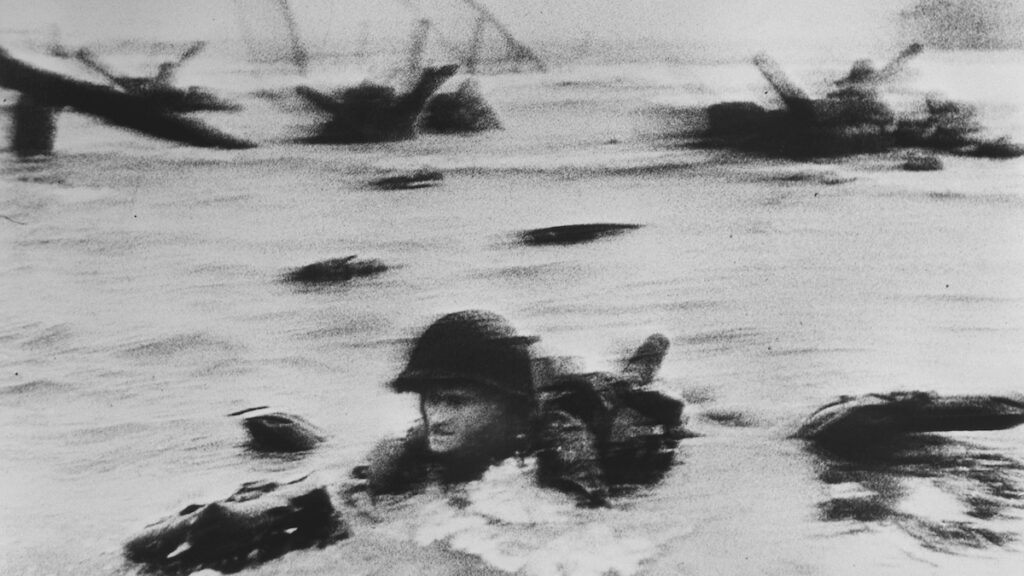A soldier crawls in the surf. War craft looms in the sea behind him. The image is blurry, mirroring the chaotic motion of the real-life scene: D-Day.
Robert Capa’s iconic photograph of a soldier in the sea captures one of the defining battles of World War II on a human scale. On June 6, 1944—80 years ago this year—the war reached a turning point when 160,000 Allied troops stormed the beaches of Normandy in what would become the largest sea invasion in history.
The waterlogged men who swam, stumbled, and crawled onto the French coastline that day were armed with rifles—and Capa was armed with his camera. It became a lens that would give millions of civilians a glimpse of the horrors of war. But even though Capa survived the battle, his photographs nearly didn’t.
Who was Robert Capa?
By the time he was 30 years old, Hungarian-born Capa was already a veteran photojournalist whose work had garnered international attention. His photographs of the Spanish Civil War chronicled the brutal realities of the conflict and the heroism of the anti-fascist Republican fighters.
Capa’s experience in Spain intimately acquainted him with the risks that came with war photography. His partner Gerda Taro, another photojournalist, was killed in 1937 while they were documenting the war in Spain.
And now, contracted with Life magazine, Capa turned his lens to northern France, where the Allies’ planned invasion aimed to turn the tide of World War II. Germany had occupied France since 1940, and if the Allies could wrest the country from the Nazis’ grip, then they could liberate Western Europe.
(Top secret maps reveal the massive Allied effort behind D-Day.)
Capa wrote in his 1947 memoir Slightly Out of Focus that he opted to join the first wave of troops landing on Omaha Beach. As the frontline of the invasion, these troops would bear the brunt of Germany’s heavy defenses.
Capa knew he risked death. The Allied Public Relations Division asked him to write a will before D-Day, and he had even written a farewell letter to his family, just in case.
Capturing the invasion
In the early morning of June 6, Capa joined soldiers on a landing boat bound for Omaha Beach. One hundred yards from shore, everyone jumped into the waist-deep water, wading toward the beach while dodging German fire.
As Capa recalled in his memoir, “The bullets tore holes in the water around me.”
When he finally reached the beach, Capa kept low to the ground to escape bullets whirring overhead. Corpses piled up around him. The only thing to do was keep taking pictures, including the photograph of the lone soldier crouching in the sea. Capa never identified the man, but the picture likely depicts Huston S. Riley, a soldier from Washington. American soldier Edward K. Regan has also been put forward as the figure.
(Traveling to Normandy’s beaches is still a deeply moving experience.)
Capa estimated that after an hour and a half, he had exhausted his film—and himself. Surrounded by exploding shells, he began to shake. He hitched a ride off the beach with a landing craft that had just delivered a group of medics.
Capa escaped with his life, but thousands of Allied troops weren’t so lucky. By the day’s end, more than 4,000 were dead.
Only a few of Capa’s D-Day photos exist
Capa wrote that he had snapped 106 photographs on multiple film rolls, which he sent to Life magazine’s London office. But in the rush to print the photographs, so the story goes, nearly all of Capa’s negatives were accidentally destroyed in the darkroom when a drying cabinet overheated.
Yet some have cast doubt on this story and parts of Capa’s D-Day account. Photography critic A.D. Coleman later interrogated Capa’s claims, concluding that he may have been on the beach only long enough to take a handful of pictures. The darkroom disaster, he argued, never happened.
Whatever actually occurred, the result was the same: Only 11 negatives survived, as Life picture editor John Morris would later clarify.
Capa’s surviving photographs continue to shape the way the world remembers D-Day. Director Steven Spielberg even used the pictures as inspiration for the D-Day scene in his acclaimed film Saving Private Ryan.
Still, none of the images Capa produced on June 6 captured D-Day quite like the soldier crawling in the surf. It put a human face on the historic event: a soldier—his expression a picture of focus and resolve—doing his duty in the midst of hell.
>>> Read full article>>>
Copyright for syndicated content belongs to the linked Source : National Geographic – https://www.nationalgeographic.com/premium/article/robert-capa-d-day-photograph
